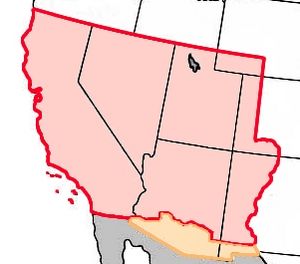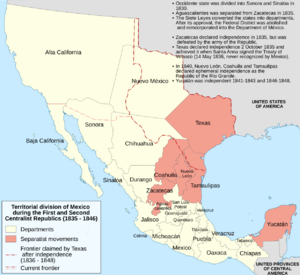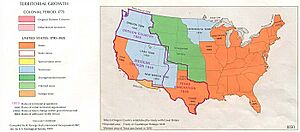Mexican Cession facts for kids
The Mexican Cession was a large area of land that Mexico gave to the United States in 1848. This happened at the end of the Mexican–American War. The territory became the states of California, Nevada, Utah, and Arizona.
This agreement was part of the Treaty of Guadalupe Hidalgo, which officially ended the war (1846–1848). The treaty was signed on February 2, 1848. The Cession added about 500,000 square miles (1.3 million km²) to the southwestern United States. This event also helped the United States become a world power in the late 1800s.
Contents
The Treaty That Ended the War
The regions of Alta California and Santa Fe de Nuevo Mexico were taken by the U.S. early in the war. The last fighting there ended in January 1847. However, Mexico did not want to give up this land.
So, in 1847, U.S. troops went into central Mexico. They even took over Mexico City, the capital. But no Mexican government was ready to agree to give up the northern territories. It was hard to know if a treaty could be made. Some people in the U.S. even wanted to take all of Mexico!
Finally, Nicholas Trist helped create the Treaty of Guadalupe Hidalgo in early 1848. This treaty clearly set the new border between Mexico and the United States. Even though Mexico didn't "cede" (officially give up) land, the new border meant Alta California and Santa Fe de Nuevo Mexico were now under U.S. control. The new border also recognized that Mexico had lost Texas. Mexico had not officially accepted this loss before.
The U.S. Senate approved the treaty. The United States also paid Mexico $15,000,000 for the land. This payment was used to help pay off Mexico's debts to U.S. citizens. So, while it seemed like a purchase, it was more like a credit against debt.
The Mexican Cession (not counting land claimed by Texas) was about 525,000 square miles (1.36 million km²). This was about 15% of the current size of the United States. If you include the disputed western Texas claims, it was about 750,000 square miles (1.9 million km²). Overall, Mexico lost 54% of its territory that it had before 1836.
For about 15 years, from 1821 (when Mexico became independent) to 1836 (when Texas revolted), the Mexican Cession area (without Texas) was about 42% of Mexico. Before that, it was part of the Spanish colony of New Spain for about 300 years.
Slavery and New Territories
Soon after the war began, people in the U.S. started arguing about slavery in the new territories. This caused a big conflict between the Northern and Southern states. This disagreement lasted for four years. During this time, the California Gold Rush brought many people to California. Also, Mormon pioneers settled in Utah.
Here are some ideas that were discussed:
- The Wilmot Proviso: This idea, proposed by Congressman David Wilmot, wanted to ban slavery in any new land taken from Mexico. It passed in the House of Representatives but not the Senate.
- Extending the Missouri Compromise line: Some wanted to extend a line (the 36°30' parallel north) across the U.S. to the Pacific Ocean. This would allow slavery south of the line.
- Popular sovereignty: This idea meant that the people in each new territory would vote to decide if they wanted slavery or not.
- President Zachary Taylor's plan: He suggested that the entire area become two free states, California and New Mexico. This would avoid the question of slavery in the territories.
- The State of Deseret: The Mormons proposed a large state called Deseret. President Taylor even considered combining California and Deseret into one state.
Finally, the Compromise of 1850 was put into action in September 1850. This agreement allowed California to join the U.S. as a free state. It also created the Utah Territory and New Mexico Territory. In these new territories, the people would decide on slavery using popular sovereignty. Texas also gave up its claims to disputed land in return for help with its debts. The slave trade was also stopped in Washington, D.C., and the Fugitive Slave Act was made stronger.
The Gadsden Purchase
After the Mexican Cession, it became clear that there wasn't an easy way to build a transcontinental railroad to a southern port. The mountains in the New Mexico Territory made it hard to build a railroad going south. Southerners wanted a railroad that would bring business to their region. So, they pushed for the U.S. to buy more land from Mexico. This led to the Gadsden Purchase in 1853, which added more land suitable for a railroad.
Images for kids
See also
 In Spanish: Cesión mexicana para niños
In Spanish: Cesión mexicana para niños





